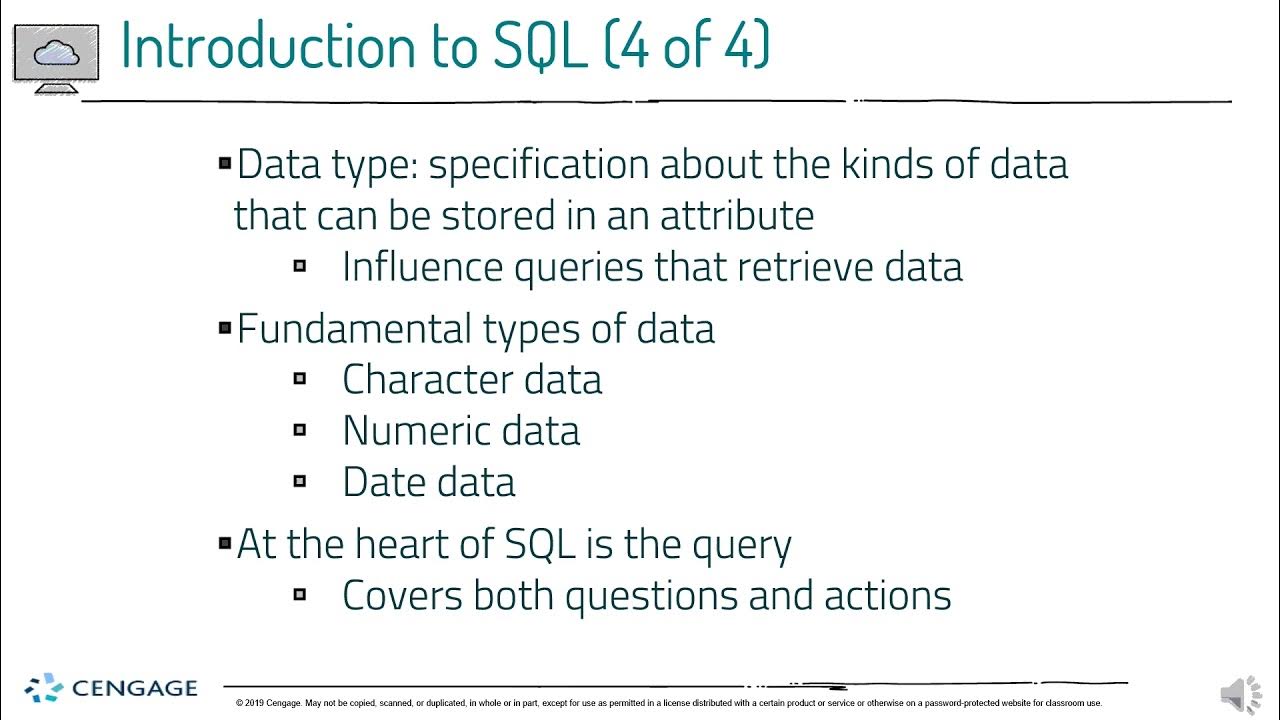Introduction to SQL
Summary
TLDRThis video introduces SQL, a non-procedural language for querying and managing data, distinct from other programming languages. Despite its 1974 origins at IBM, SQL remains vital for data science roles like business analyst and data engineering. It operates directly on data, enhancing efficiency. As an ANSI standard, SQL's syntax varies across databases like MySQL, PostgreSQL, and Oracle, but its fundamentals are transferable. SQL interfaces also extend to NoSQL and big data, demonstrating its adaptability.
Takeaways
- 🗣️ SQL is pronounced 'ess cue el' or 'sequel'.
- 💾 SQL is a non-procedural language used for querying and managing data.
- 🧮 SQL is considered simple and powerful, especially for data scientists.
- 📚 SQL is older than Python and R by about 20 years, first appearing in 1974.
- 🏢 SQL was developed by IBM for managing data in relational databases.
- 📊 A relational database is structured with collections of two-dimensional tables.
- 🔗 SQL can also interface with NoSQL and big data repositories.
- 📝 SQL is composed of clauses, expressions, predicates, queries, and statements.
- 🛠️ Knowing SQL is beneficial for various data science roles, including business and data analyst, and data engineering.
- 🚀 SQL allows direct data access, potentially speeding up workflow executions.
- 🌐 SQL is an ANSI standard, making it widely applicable across different databases.
- 📚 There are many SQL databases available, each with potentially different syntax nuances.
- 🏫 Focusing on a specific relational database and engaging with its community is advisable for learning SQL.
Q & A
How is SQL pronounced and what does it stand for?
-SQL is formally pronounced 'ess cue el,' although some people say 'sequel.' It stands for 'Structured Query Language.'
Why is SQL considered different from other programming languages?
-SQL is considered different because it is a non-procedural language with a limited scope to querying and managing data.
Why do data scientists use SQL despite it not being a 'data science' language?
-Data scientists use SQL because it is simple and powerful for handling data.
How old is SQL and where was it first developed?
-SQL is older than Python and R by about 20 years, having first appeared in 1974, and it was developed at IBM.
What is the primary use case for SQL?
-SQL is primarily used for managing data in relational databases.
What is the structure of a relational database?
-A relational database is formed by collections of two-dimensional tables with a fixed number of columns and any number of rows.
Can SQL be used with NoSQL and big data repositories?
-Yes, SQL interfaces for many NoSQL and big data repositories have been developed due to SQL's pervasiveness and ease of use.
What are the language elements of SQL?
-SQL is subdivided into clauses, expressions, predicates, queries, and statements.
What benefits does knowing SQL provide in data science?
-Knowing SQL helps in various data science roles like business and data analyst, and it's essential in data engineering.
How does SQL speed up workflow executions?
-SQL accesses data directly without the need to copy it beforehand, which can considerably speed up workflow executions.
What does it mean for SQL to be an 'ANSI' standard?
-SQL being an American National Standards Institute standard means that SQL knowledge is transferable across various databases.
What are some of the different SQL databases available?
-Some SQL databases include MySQL, IBM Db2, PostgreSQL, Apache, OpenOffice Base, SQLite, Oracle, MariaDB, and Microsoft SQL Server.
How might the syntax of SQL vary between different relational database management systems?
-The syntax of SQL might change slightly based on the relational database management system being used.
What is the recommended approach to learning SQL?
-Focus on a specific relational database and engage with its community, and consider taking introductory courses on SQL.
Outlines

Этот раздел доступен только подписчикам платных тарифов. Пожалуйста, перейдите на платный тариф для доступа.
Перейти на платный тарифMindmap

Этот раздел доступен только подписчикам платных тарифов. Пожалуйста, перейдите на платный тариф для доступа.
Перейти на платный тарифKeywords

Этот раздел доступен только подписчикам платных тарифов. Пожалуйста, перейдите на платный тариф для доступа.
Перейти на платный тарифHighlights

Этот раздел доступен только подписчикам платных тарифов. Пожалуйста, перейдите на платный тариф для доступа.
Перейти на платный тарифTranscripts

Этот раздел доступен только подписчикам платных тарифов. Пожалуйста, перейдите на платный тариф для доступа.
Перейти на платный тариф5.0 / 5 (0 votes)






